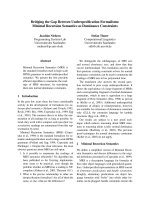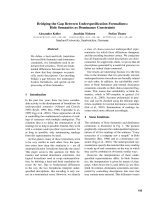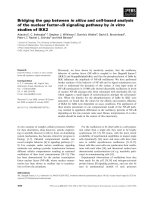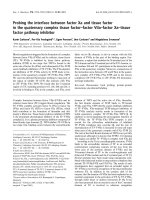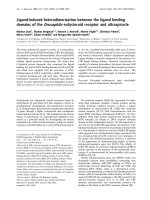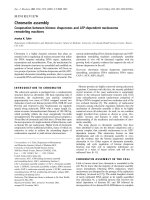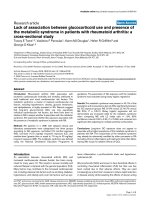Báo cáo y học: "DeDefining the relationship between gastroesophageal reflux and cough: probabilities, possibilities and limitations" ppt
Bạn đang xem bản rút gọn của tài liệu. Xem và tải ngay bản đầy đủ của tài liệu tại đây (323.3 KB, 5 trang )
BioMed Central
Page 1 of 5
(page number not for citation purposes)
Cough
Open Access
Commentary
Defining the relationship between gastroesophageal reflux and
cough: probabilities, possibilities and limitations
Matthew M Eastburn
1,2
, Peter H Katelaris
3
and Anne B Chang*
1,4
Address:
1
Department of Respiratory Medicine, Royal Children's Hospital, Brisbane, Australia,
2
School of Information Technology and Electrical
Engineering, University of Queensland, St Lucia, Queensland, Australia,
3
Department of Gastroenterology, University of Sydney, Concord
Hospital, Sydney, Australia and
4
Child Health Division, Menzies School of Health Research, Darwin, Northern Territory, Australia
Email: Matthew M Eastburn - ; Peter H Katelaris - ;
Anne B Chang* -
* Corresponding author
Abstract
The common co-existence of cough and gastroesophageal reflux disease (GORD) is well
established. However, ascertaining cause and effect is more difficult for many reasons that include
occurrence by chance of two common symptoms, the changing definition of GORD, equipment
limitations and the lack of randomised controlled trials. Given these difficulties, it is not surprising
that there is disparity of opinion between respiratory and gastroenterology society guidelines on
the link between GORD and chronic cough. This commentary explores of these issues.
Background
The first guideline on the management of cough champi-
oned by Irwin [1] made a significant positive impact. Not
surprisingly other guidelines on chronic cough [2-5] have
since been published. American [2], European [3] and
British [5] respiratory guidelines for the management of
chronic unexplained cough in adults advocate empirical
treatment of gastroesophageal reflux disease (GORD)
with a variety of medications including proton pump
inhibitors (PPIs). In contrast, guidelines from some
national gastroenterological societies are less definitive
about the association between cough and GORD [6-9]
Paediatric cough guidelines do not favour the empirical
approach in adults because GORD as a cause of isolated
cough is rare in children [10,11]. Is there evidence for a
true difference or do these differences exist because opin-
ion leaders in their respective fields have different views?
In this commentary, important limitations in understand-
ing the association between cough and GORD are
explored.
That cough and GORD commonly coexist is indisputable
in both children [12] and adults [13]. The questions of
whether this is 'cause and effect' [14], 'whether GORD
causes cough or vice versa' [15] and 'how commonly can
the symptom of cough be attributed to GORD' remain
controversial [9,16]. Nevertheless the problem is real; in
the community the burden of cough and GORD, in isola-
tion or in combination, is high. Chronic cough is associ-
ated with significant morbidity [17] and the economic
cost in terms of medications alone, is billions of dollars
[18]. Empirical acid antisecretory treatment of cough in
adults adds to this cost. In Australia alone, where the costs
of medications are heavily subsided by the government,
three PPIs are in the top 10 drugs by cost [19]. In 2006
these 3 PPIs alone costs the Australian tax payers almost
A$42.5 million [19].
Published: 20 March 2007
Cough 2007, 3:4 doi:10.1186/1745-9974-3-4
Received: 30 January 2007
Accepted: 20 March 2007
This article is available from: />© 2007 Eastburn et al; licensee BioMed Central Ltd.
This is an Open Access article distributed under the terms of the Creative Commons Attribution License ( />),
which permits unrestricted use, distribution, and reproduction in any medium, provided the original work is properly cited.
Cough 2007, 3:4 />Page 2 of 5
(page number not for citation purposes)
Cough and reflux: two common symptoms,
chance occurrence and which came first?
In many developed countries, cough is the most common
symptom presenting to doctors [18,20]. Chronic cough
can affect up to 20% of the population [21] whilst the
prevalence of GORD in Western populations is up to 25%
[22]. Thus the upper limit of probability of a chance asso-
ciation as independent events is 5% of the population. In
selected patient cohort studies the higher prevalence of
these symptoms would increase the likelihood of a chance
occurrence. That is, in a cohort study of subjects with
chronic cough, the chance occurrence of GORD as an
independent event may be up to 25%.
Not only is it possible that two common symptoms may
coexist merely by chance but determining which symp-
tom came first is difficult and opinions vary. Acutely,
cough can precipitate reflux events as shown objectively
by Paterson and Murat [23] with cough bursts defined on
oesophageal manometry. Using ambulatory pressure-pH-
impedance monitoring, Sifrim and colleagues reported
that the majority (69.4%) of cough events in subjects with
chronic cough, were considered independent of reflux,
whereas 30.6% occurred within two minutes of a reflux
episode [24]. In a review using strict definitions, Dent and
colleagues found that "in the year following the diagnosis
of GORD, patients were at increased risk of a first time
diagnosis of cough (OR 1.7, 95% CI 1.4–2.1), angina (OR
3.2, 95% CI 2.1–4.9), gall bladder disease (OR 3.7, 95%
CI 2.1–6.7), sinusitis (OR 1.6, 95% CI 1.2–2.0) and chest
pain (OR 2.3, 95% CI 1.8–2.8) [25]. However, despite the
reported frequency of assumed cough from GORD and
the common clinical observation that treatment for
GORD may lead to resolution of cough, at least in some
people [26,27] there is glaring lack of published ran-
domised trials [28].
Differences between respiratory and
gastroenterology society publications
There is a degree of variance between adult respiratory and
gastroenterological society guidelines when considering a
possible association between airway symptoms and
GORD. While gastroenterological society publications
have been more cautious in linking upper airway symp-
toms to GORD [6-9,29], adult respiratory ones largely
endorse the cause and effect [5,30]. Recent gastroenterol-
ogy society recommendations are based largely on system-
atic reviews and meta-analysis [9,31]. In contrast, the
latest published cough guideline [5] omitted meta-analy-
sis data [27,28] which had similar findings to the
approach adopted by gastroenterology societies [6-9,29].
Defining GORD- the changing goal posts
Reflux of gastric contents into the oesophagus can be
acidic, weakly acidic or weakly alkaline (non acid reflux)
and includes 'volume' reflux. Prior to the description of
non-acid or weakly acidic reflux, proponents that cough is
commonly caused by GORD have described that almost
all (>75%) cough (if not all) was associated with acidifi-
cation of the oesophagus and/or resolved with acid sup-
pression therapy [32-34]. However, non-acid reflux can
now be measured using multi-channel intraluminal
impedance combined with pH monitoring and has been
shown to be associated with an undefined but significant
proportion of GORD associated cough [24]. Indeed, until
the last 12 months pH monitoring for acid reflux was the
recommended standard for defining cough associated
with GORD with published positive and negative predic-
tive values of 89 and 100% respectively [2,3]. However,
the predictive value of pH monitoring has been ques-
tioned even for the diagnosis of GORD itself [35] with no
agreement about the gold standard for the diagnosis of
GORD [6]. Furthermore, while the definition of abnormal
acidification has been largely agreed, with three age
dependent cut-offs [6,8], such definitions for associating
GORD to cough remains indeterminate. The belief in
adult respiratory practice, that cough related to GORD
may occur without any reflux symptoms [5] results in fre-
quent empirical therapy for any patient with chronic
cough with or without GORD symptoms. However, a
recent international consensus statement (The Montreal
Delphi consensus report) following a review of the litera-
ture concluded that unexplained laryngeal and respiratory
symptoms were unlikely to be related to GORD in the
absence of heartburn or regurgitation and that typical
heartburn and regurgitation are highly specific for GORD
[9].
Equipment limitations
Almost all (if not all) commercial pHmetry systems have
a maximum capture or download rate of 0.25 Hz. That is,
data points are recorded once every 4 seconds. The active
respiratory muscle phase of a single cough epoch lasts
0.6–0.8 secs (figure 1) and the glottic closure phase of
cough whereby the greatest intrathoracic pressure is gen-
erated lasts 0.2 secs [36]. Thus an objective study of cough
and reflux would require a capture rate of at least 5 Hz
(one data point every 0.2 secs) to ascertain if cough occurs
before a reflux event. Subjective scoring or event marking
on a commercial system is highly inaccurate as far as tim-
ing is concerned, so it is not possible to know whether a
cough occurs before a pH drop (or vice versa) when data
is captured once every 4 secs. Furthermore, data captured
on synchronised (for example to the nearest second) sep-
arate instruments as opposed to a single time frame will
give erroneous results given that resolution rates has to be
less than the compressive phase of a cough when intratho-
racic pressures peaks up to 300 mmHg [36] as it is the
phase most likely associated with a reflux event. This is
illustrated in figure 1 obtained using a specifically built
Cough 2007, 3:4 />Page 3 of 5
(page number not for citation purposes)
pHmetry-cough-logger with a capture rate of 10 Hz (ie 10
data points every one sec).
Sifrim and colleagues [24] used manometry and pHmetry
(at a slow capture rate 0.25 Hz) to define the occurrence
of acid reflux to cough (in addition to other data). How-
ever, 'cough' was defined on manometry data and current
manometry labelling of 'cough' has only been partially
validated when compared to how cough loggers are vali-
dated [37,38]. Physiologically, changes seen in oesopha-
geal manometry reflect intra-thoracic changes and thus
events such as sneeze, hiccups, throat-clearing manoeu-
vres would appear similar to coughs, as shown in respira-
tory muscle EMG changes. Thus, it is likely that the
association reported was over-estimated.
Acute vs chronic data: are they related?
In addition to the above, it is unknown if acute effects
related to cough preceding or following a reflux event is
relevant to the management of chronic cough. In view of
equipment limitations, it is not surprising that there are
no publications on this, or any controlled trials. It is bio-
logically possible that cough takes a longer time to resolve
following treatment compared to typical reflux symptoms
if there is up-regulation of cough neuro-pathway [39] that
may take time to re-equilibrate. However in Ours and col-
leagues randomised controlled trial, the 'time to response'
was 2 weeks [26].
Laryngo-pharyngeal reflux (LPR)?
Ear, nose and throat (ENT) diseases and LPR are widely
regarded as a cause of chronic cough related to GORD.
However, all controlled trials to date where subjects were
enrolled from ENT clinics and cough was an outcome
measure have shown that GORD treatment is not effica-
cious when compared to placebo [28]. Two additional
controlled studies since a comprehensive review [16] also
showed that neither PPI nor fundoplication were effica-
Cough preceding a pH drop followed by another coughFigure 1
Cough preceding a pH drop followed by another cough. Recordings from a specifically built pHmetry-cough-logger with a cap-
ture rate of 10 Hz (40 times the commercially available systems). Time scale in hours:mins:secs.
Cough 2007, 3:4 />Page 4 of 5
(page number not for citation purposes)
cious [40,41]. The former was the largest study involving
GORD therapy with cough as an outcome (n = 145). In
contrast, "uncontrolled studies suggest that 40–100% of
patients who have suspected acid-related ENT symptoms
improve on aggressive anti-reflux therapy" [16].
The way forward?
Consumers and medical practitioners may be content to
resort to a therapeutic trial for at least 3 months in all cases
of chronic unexplained cough, as suggested by some [5].
Despite the apparent convenience of such an approach, it
is not without risk of adverse events [42,43], incurs signif-
icant costs and is contrary to the emerging evidence that
suggests that this strategy will meet with infrequent suc-
cess particularly when cough is not associated with typical
reflux symptoms. The advice of Bourke and Drumm
(when discussing the history of the use of cisapride for
GORD) advocated that guidelines must be multidiscipli-
nary, based on systematic review of published work, and
should explicitly link recommendations to the supporting
evidence, is pertinent despite the excellent safety record of
PPIs [44].
Further study of this relatively common clinical conun-
drum is clearly required. High quality placebo controlled
randomised trials using a combination of objective and
subjective outcomes in both adults and children [28] are
needed. Furthermore, better characterisation of the pre-
dictive value of clinical features and measurable abnor-
malities of GORD associated with cough will result in
better selection of patients for therapeutic trials of PPIs or
other therapies. Moreover, the duration of therapy and
time to response needs to be better defined as advice by
some that treatment for cough associated with reflux can
take up to one year is impractical. Lastly, to accurately and
definitively relate cough to pH change temporally, it may
be necessary to have an instrument with a sufficiently fast
capture, recording rate and response time to allow more
precise data collection, something that is lacking in cur-
rently available commercial pHmetry recorders for studies
relating to cough.
Conclusion
The common co-existence of cough and GORD is well
established. By chance alone the occurrence of these as
independent events may be as high as 5% of the general
population. Ascertaining cause and effect is however more
difficult. Although some patients may have resolution of
chronic cough with therapies for GORD there is still insuf-
ficient evidence to determine whether GORD is a com-
mon cause of chronic cough. A multi-disciplinary
approach involving respiratory physicians, gastroenterol-
ogists and ENT surgeons is required to better define this
association and to promulgate consistent guidelines
based on the best evidence. Until randomised placebo
controlled clinical trials are performed with adequate
power and using adequate instrumentation guidance for
therapy in clinical practice will remain based on sub-opti-
mal evidence and this conundrum will remain unre-
solved.
Acknowledgements
A Chang is supported by the Royal Children's Hospital Foundation and a
NHMRC Practitioner Fellowship.
References
1. Irwin RS, Boulet LP, Cloutier MM, Fuller R, Gold PM, Hoffstein V, Ing
AJ, McCool FD, O'Byrne P, Poe RH, Prakash UB, Pratter MR, Rubin
BK: Managing cough as a defense mechanism and as a symp-
tom. A consensus panel report of the American College of
Chest Physicians. Chest 1998, 114:133S-181S.
2. Irwin RS, Baumann MH, Bolser DC, Boulet LP, Braman SS, Brightling
CE, Brown KK, Canning BJ, Chang AB, Dicpinigaitis PV, Eccles R,
Glomb WB, Goldstein LB, Graham LM, Hargreave FE, Kvale PA,
Lewis S, McCool FD, McCrory DC, Prakash UB, Pratter MR, Rosen
MJ, Schulman E, Shannon JJ, Smith Hammond C, Tarlo SM: Diagnosis
and Management of Cough Executive Summary: ACCP Evi-
dence-Based Clinical Practice Guidelines. Chest 2006,
129:1S-23.
3. Morice AH, members C: The diagnosis and management of
chronic cough. Eur Respir J 2004, 24:481-492.
4. Kohno S, Ishida T, Uchida Y, Kishimoto H, Sasaki H, Shioya T,
Tokuyama K, Niimi A, Nishi K, Fujimura M, Matsuse H, Suzaki H: The
Japanese Respiratory Society guidelines for management of
cough. Respirology 2006, 11 Suppl 4:S135-S186.
5. Morice AH, McGarvey L, Pavord I: Recommendations for the
management of cough in adults. Thorax 2006, 61 Suppl 1:i1-i24.
6. Armstrong D, Marshall JK, Chiba N, Enns R, Fallone CA, Fass R,
Hollingworth R, Hunt RH, Kahrilas PJ, Mayrand S, Moayyedi P, Pater-
son WG, Sadowski D, van Zanten SJ: Canadian Consensus Con-
ference on the management of gastroesophageal reflux
disease in adults - update 2004. Can J Gastroenterol 2005,
19:15-35.
7. Katelaris P, Holloway R, Talley N, Gotley D, Williams S, Dent J: Gas-
tro-oesophageal reflux disease in adults: Guidelines for clini-
cians. J Gastroenterol Hepatol 2002, 17:825-833.
8. Rudolph CD, Mazur LJ, Liptak GS, Baker RD, Boyle JT, Colletti RB,
Gerson WT, Werlin SL: Guidelines for evaluation and treat-
ment of gastroesophageal reflux in infants and children: rec-
ommendations of the North American Society for Pediatric
Gastroenterology and Nutrition. J Pediatr Gastroenterol Nutr
2001, 32 Suppl 2:S1-31.
9. Vakil N, van Zanten SV, Kahrilas P, Dent J, Jones R: The Montreal
definition and classification of gastroesophageal reflux dis-
ease: a global evidence-based consensus. Am J Gastroenterol
2006, 101:1900-1920.
10. Chang AB, Glomb WB: Guidelines for evaluating chronic cough
in pediatrics: ACCP Evidence-Based Clinical Practice Guide-
lines. Chest 2006, 129:260S-283.
11. Chang AB, Landau LI, van Asperen PP, Glasgow NJ, Robertson CF,
Marchant JM, Mellis CM: The Thoracic Society of Australia and
New Zealand. Position statement. Cough in children: defini-
tions and clinical evaluation. Med J Aust 2006, 184:398-403.
12. Chang AB, Cox NC, Faoagali J, Cleghorn GJ, Beem C, Ee LC, Withers
GD, Patrick MK, Lewindon PJ: Cough and reflux esophagitis in
children: their co-existence and airway cellularity. BMC Pedi-
atr 2006, 6:4.
13. Irwin RS, French CL, Curley FJ, Zawacki JK, Bennett FM: Chronic
cough due to gastroesophageal reflux. Clinical, diagnostic,
and pathogenetic aspects. Chest 1993, 104:1511-1517.
14. Ahmed T, Vaezi MF: The role of pH monitoring in extraesopha-
geal gastroesophageal reflux disease. Gastrointest Endosc Clin N
Am 2005, 15:319-331.
15. Laukka MA, Cameron AJ, Schei AJ: Gastroesophageal reflux and
chronic cough: which comes first? J Clin Gastroenterol 1994,
19:100-104.
Publish with BioMed Central and every
scientist can read your work free of charge
"BioMed Central will be the most significant development for
disseminating the results of biomedical research in our lifetime."
Sir Paul Nurse, Cancer Research UK
Your research papers will be:
available free of charge to the entire biomedical community
peer reviewed and published immediately upon acceptance
cited in PubMed and archived on PubMed Central
yours — you keep the copyright
Submit your manuscript here:
/>BioMedcentral
Cough 2007, 3:4 />Page 5 of 5
(page number not for citation purposes)
16. Richter JE: Ear, nose and throat and respiratory manifesta-
tions of gastro-esophageal reflux disease: An increasing
conundrum. Eur J Gastroenterol Hepatol 2004, 16(9):837-845.
17. Irwin RS: Complications of Cough: ACCP Evidence-Based
Clinical Practice Guidelines. Chest 2006, 129:54S-558.
18. Irwin RS: Introduction to the Diagnosis and Management of
Cough: ACCP Evidence-Based Clinical Practice Guidelines.
Chest 2006, 129:25S-27.
19. Top 10 drugs. Australian Prescriber 2006, 29:5.
20. Britt H, Miller GC, Knox S, Charles J, Valenti L, Pan Y, Henderson J,
Bayram C, O'Halloran J, Ng A: General Practice Activity in Aus-
tralia 2003-2004. Australian Institute of Health and Welfare
2004:AIHW Cat. No. GEP 16 [ />gep/gpaa03-04/gpaa03-04.pdf]. Canberra
21. Janson C, Chinn S, Jarvis D, Burney P: Determinants of cough in
young adults participating in the European Community Res-
piratory Health Survey. Eur Respir J 2001, 18:647-654.
22. Hungin AP, Raghunath AS, Wiklund I: Beyond heartburn: a sys-
tematic review of the extra-oesophageal spectrum of reflux-
induced disease. Fam Pract 2005, 22:591-603.
23. Paterson WG, Murat BW: Combined ambulatory esophageal
manometry and dual-probe pH-metry in evaluation of
patients with chronic unexplained cough. Dig Dis Sci 1994,
39:1117-1125 [http://PM:8174426
].
24. Sifrim D, Dupont L, Blondeau K, Zhang X, Tack J, Janssens J: Weakly
acidic reflux in patients with chronic unexplained cough dur-
ing 24 hour pressure, pH, and impedance monitoring. Gut
2005, 54:449-454.
25. Dent J, El-Serag HB, Wallander MA, Johansson S: Epidemiology of
gastro-oesophageal reflux disease: a systematic review. Gut
2005, 54:710-717.
26. Ours TM, Kavuru MS, Schilz RJ, Richter JE: A prospective evalua-
tion of esophageal testing and a double-blind, randomized
study of omeprazole in a diagnostic and therapeutic algo-
rithm for chronic cough. Am J Gastroenterol 1999, 94:3131-3138.
27. Chang AB, Lasserson TJ, Kiljander TO, Connor FL, Gaffney JT, Gar-
ske LA: Systematic review and meta-analysis of randomised
controlled trials of gastro-oesophageal reflux interventions
for chronic cough associated with gastro-oesophageal reflux.
BMJ 2006, 332:11-17.
28. Chang AB, Lasserson T, Gaffney J, Connor FC, Garske LA: Gastro-
oesophageal reflux treatment for prolonged non-specific
cough in children and adults. The Cochrane Database of Systematic
Reviews 2005:Issue 2.
29. Dent J, Armstrong D, Delaney B, Moayyedi P, Talley NJ, Vakil N:
Symptom evaluation in reflux disease: workshop back-
ground, processes, terminology, recommendations, and dis-
cussion outputs. Gut 2004, 53:iv1-24.
30. Irwin RS: Chronic Cough Due to Gastroesophageal Reflux
Disease: ACCP Evidence-Based Clinical Practice Guidelines.
Chest 2006, 129:80S-894.
31. Talley NJ, Vakil N: Guidelines for the management of dyspep-
sia. Am J Gastroenterol 2005, 100:2324-2337.
32. Ing AJ, Ngu MC, Breslin AB: Pathogenesis of chronic persistent
cough associated with gastroesophageal reflux. Am J Respir Crit
Care Med 1994, 149:160-167.
33. Smyrnios NA, Irwin RS, Curley FJ: Chronic cough with a history
of excessive sputum production. The spectrum and fre-
quency of causes, key components of the diagnostic evalua-
tion, and outcome of specific therapy. Chest 1995, 108:991-997.
34. Katz PO, Castell DO: Medical therapy of supraesophageal gas-
troesophageal reflux disease. Am J Med 2000, 108(Suppl
4a):170S-177S.
35. American Gastroenterological Association medical position
statement: guidelines on the use of esophageal pH record-
ing. Gastroenterology 1996, 110:1981-1996.
36. McCool FD: Global Physiology and Pathophysiology of Cough:
ACCP Evidence-Based Clinical Practice Guidelines. Chest
2006, 129:48S-53.
37. Smith JA, Earis JE, Woodcock AA: Establishing a gold standard
for manual cough counting: video versus digital audio
recordings. Cough 2006, 2:6.
38. Chang AB, Newman RG, Phelan PD, Robertson CF: A new use for
an old Holter monitor: an ambulatory cough meter. Eur
Respir J 1997, 10:1637-1639.
39. Canning BJ: Role of nerves in asthmatic inflammation and
potential influence of gastroesophageal reflux disease. Am J
Med 2001, 111(Suppl 8A):13S-17S.
40. Vaezi MF, Richter JE, Stasney CR, Spiegel JR, Iannuzzi RA, Crawley JA,
Hwang C, Sostek MB, Shaker R: Treatment of chronic posterior
laryngitis with esomeprazole. Laryngoscope 2006, 116:254-260.
41. Swoger J, Ponsky J, Hicks DM, Richter JE, Abelson TI, Milstein C,
Qadeer MA, Vaezi MF: Surgical fundoplication in laryngopha-
ryngeal reflux unresponsive to aggressive acid suppression: a
controlled study. Clin Gastroenterol Hepatol 2006, 4:433-441.
42. Gregor JC: Acid suppression and pneumonia: a clinical indica-
tion for rational prescribing. JAMA 2004, 292:2012-2013.
43. Yang YX, Lewis JD, Epstein S, Metz DC: Long-term proton pump
inhibitor therapy and risk of hip fracture. JAMA 2006,
296:2947-2953.
44. Bourke B, Drumm B: Cochrane's epitaph for cisapride in child-
hood gastro-oesophageal reflux. Arch Dis Child 2002, 86:71-72.
